Two customers reach out for support. One glides through a chatbot, gets help in minutes, and leaves happy. The other fights endless menus, gets passed between agents, and hangs up frustrated.
Guess who’s coming back?
That’s where Customer Effort Score (CES) matters; it shows how easy (or painful) it is for people to deal with your business.
The real challenge isn’t collecting feedback; it’s turning it into fixes that actually reduce effort. That’s what customer effort score software is built for. A good CES survey tool or CES survey app doesn’t just ask questions; it captures effort in real time and translates it into clear insights your team can act on.
In this guide, we’ll break down the best CES survey software and customer effort score platforms for 2025. Whether your goal is to streamline support, cut churn, or uncover what’s tripping up customers, these tools make it possible to measure and improve effort where it counts.
What Is Customer Effort Score (CES) and Why Does It Matter?
CES measures how much effort a customer puts into solving a problem or completing a task with your business. It’s usually rated on a 1 – 7 scale, where 1 is very difficult and 7 is very easy. The data is clear: Gartner found that 94% of customers with low-effort experiences will repurchase, compared to only 4% with high-effort ones.
That’s why customer effort score software matters. A CES survey tool or CES survey app doesn’t stop at asking a question. It shows you exactly where customers are struggling and gives you the chance to fix it. The right customer effort score platform turns feedback into a loyalty advantage.
Unlike NPS, which tracks advocacy, or CSAT, which measures happiness, CES is about ease. Use it to spot friction in areas like checkout, onboarding, or support. Together, CES, NPS, and CSAT give you a full picture: CES removes obstacles, NPS tells you who promotes you, and CSAT shows who’s satisfied in the moment.
9 Best Customer Effort Score Software for 2025
Over the last few months, I connected with market leaders to know their take on the best CES survey tools. I also did my round of research, sought peer recommendations, and checked user feedback from software review sites to come up with this exhaustive list. Here’s your first glance at them:
| Customer Effort Score Software | Best For | Pricing | G2 Rating (out of 5) |
|---|---|---|---|
| ProProfs Survey Maker | Free Online Survey Creation | Free plan available. Paid plan starts at $19.99/month | 4.6 |
| SurveyMonkey | General Surveys & Questionnaires | $25/user/month | 4.4 |
| Qualaroo | AI-Powered Sentiment Analysis | Free plan available. Paid plan starts at $19.99/100 responses/month | 4.5 |
| Qualtrics | Enterprise-Level Surveys | $1,500/year (custom pricing) | 4.4 |
| InMoment | Experience Intelligence | Custom Pricing | 4.5 |
| QuestionPro | Enterprise-Grade Market Research | $99/user/month | 4.6 |
| SurveySparrow | Omnichannel Experience Management | $19/month (custom pricing) | 4.7 |
| Typeform | Interactive & Conversational Surveys | $25/month | 4.5 |
| Jotform | Creating Online Forms | $34/month | 4.7 |
1. ProProfs Survey Maker – Best for Easily Creating & Conducting NPS & CSAT Surveys
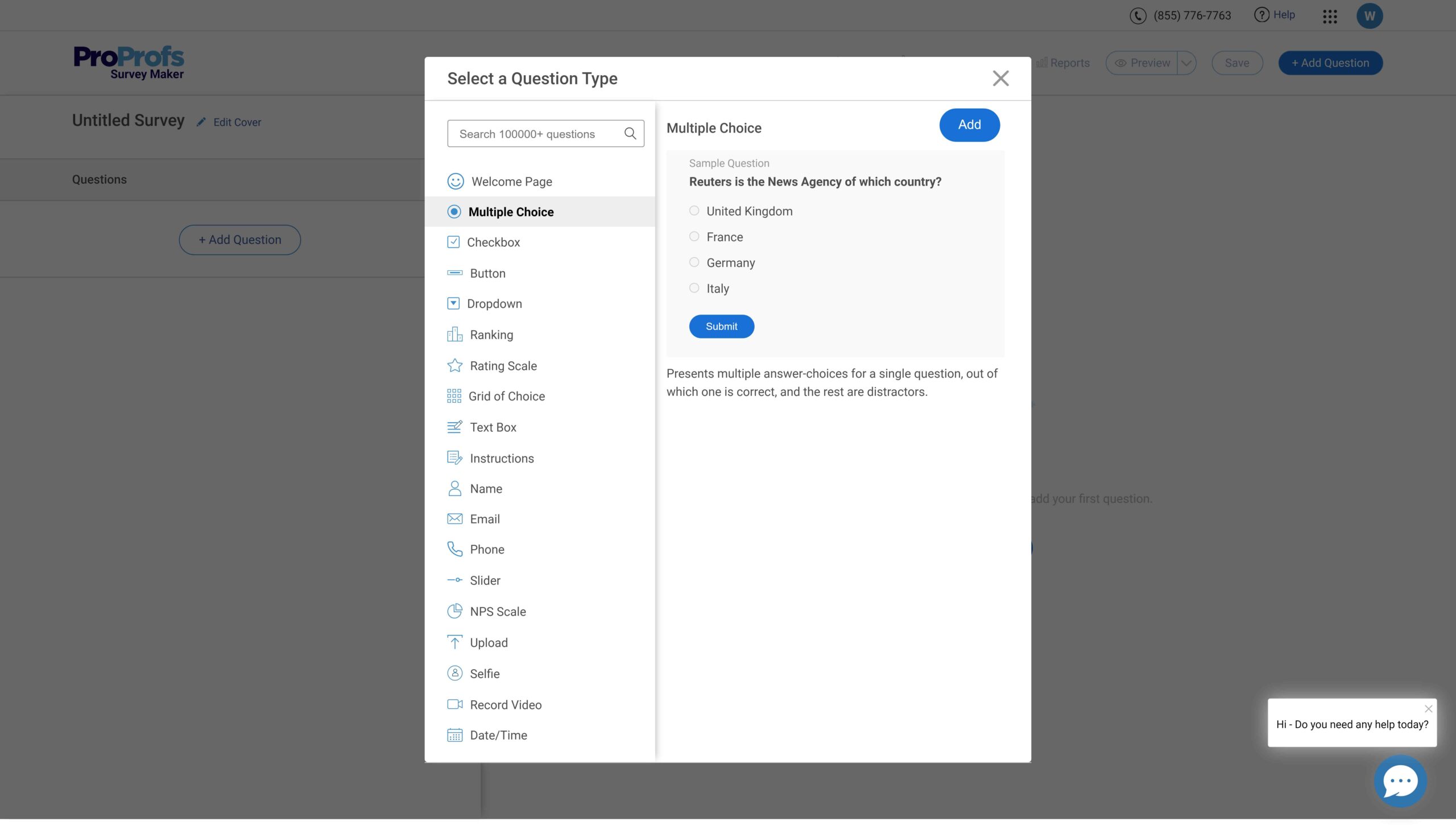
ProProfs Survey Maker is one of the most reliable tools I’ve used for creating Customer Effort Score and Net Promoter Score surveys. Its AI makes building surveys fast and effortless, with no complex setup and no technical hassle. I’ve been using it for a while now, and it’s been a smooth, efficient experience throughout.
What I like most is how easy it is to create surveys that actually engage people. You can pick from 100+ templates or build your own using the drag-and-drop editor. Features like branching and skip logic make every question feel more personal and relevant to the respondent.
The real win, though, is in the insights. ProProfs gives you live analytics that clearly show what’s working and what’s not. You can spot patterns, track satisfaction levels, and make smarter decisions to improve the customer experience, all in one place.
Pros:
- AI assistance to build surveys faster and smarter
- Reports that automatically calculate CES scores
- White-labeled surveys for seamless brand integration
- Logic jumps and branching for personalized surveys
- Powerful data filtering and segmentation capabilities
- Multi-channel distribution for enhanced reach
Cons:
- The pricing plans could have been clearer for convenience
- No option to switch between light and dark modes
Pricing:
Free plan for up to 50 responses. Paid plan starts at $19.99/month.
2. SurveyMonkey – Best for General Surveys & Questionnaires
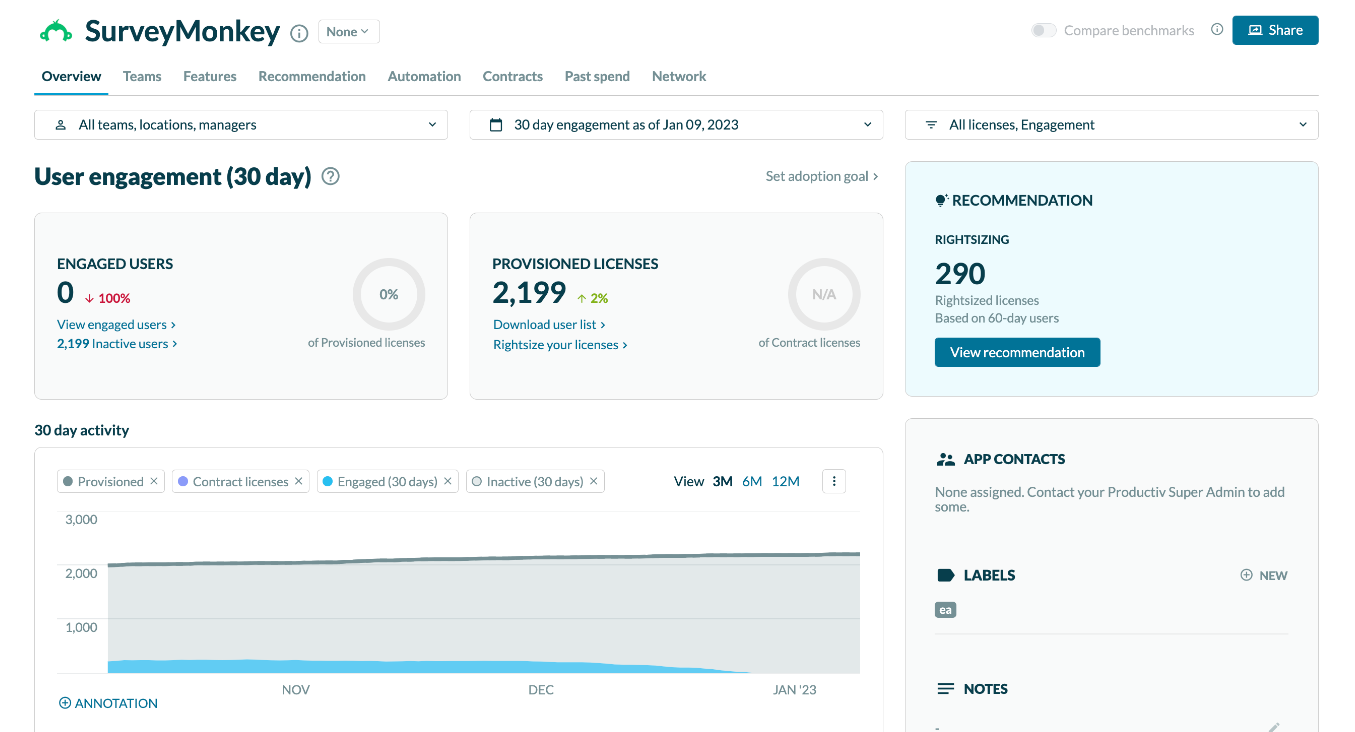
(Image Source: SurveyMonkey)
SurveyMonkey is another versatile CES tool that excels in facilitating general surveys and questionnaires.
It lets you create and send CES surveys to customers. You can choose from a variety of question types and answer formats and customize the surveys with your own logo and colors. I liked SurveyMonkey’s expert-designed templates and sample questions – perfect to get started quickly.
The software integrates with many apps and platforms, such as Slack, HubSpot, Salesforce, and more, so you can collect feedback from different sources and sync your data. You can also analyze survey results with SurveyMonkey’s advanced reporting and analytics tools and get insights to improve your customer effort score.
Pros:
- Extensive question library and customizable templates
- Multiple question types to suit different survey requirements, including CES
- Mobile-friendly surveys for enhanced respondent experience
- Automation options for recurring surveys
- Survey distribution via email, web, social media, and more
Cons:
- Limited survey design customization options
- Some users have reported occasional technical issues with survey response tracking
Pricing:
Starts at $25/user/month.
3. Qualaroo – Best for AI-Powered Sentiment Analysis
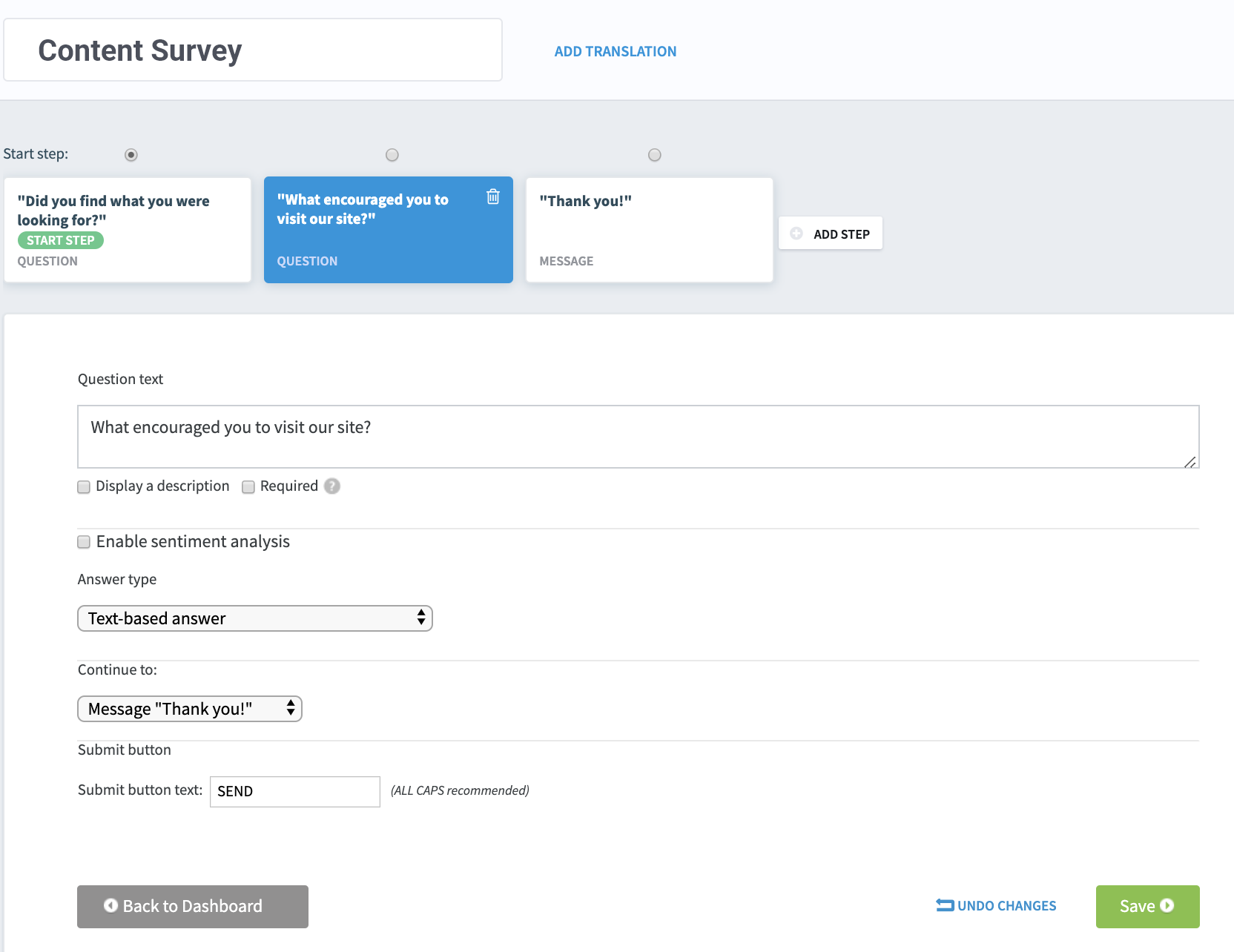
(Image Source: Qualaroo)
Qualaroo is a unique tool that uses AI-powered sentiment analysis to measure and improve customer effort scores. It enables you to create CES surveys on your website or app and capture customer feedback at the right moment.
I have used Qualaroo’s “Nudge™” technology to ask relevant and contextual questions to my target audience. I received honest and accurate responses – which is really great. You can also use the sentiment analysis engine to understand the emotions behind your customers’ feedback and get deeper insights into their pain points and expectations.
Qualaroo integrates with tools like Google Analytics, Segment, Optimizely, and more so you can enrich your data and optimize customer experience.
Pros:
- AI-powered sentiment analysis for accurate customer feedback interpretation
- Personalized survey targeting based on user behavior
- Easy integration with existing customer feedback channels
- Customizable survey reports that automatically show customer effort score
- A/B testing of surveys to optimize customer experience
Cons:
- The tool could do some more templates for specific industries
- There could be more format options like Word Documents, PowerPoint slides, and XLS to export data
Pricing:
A free plan is available. Paid options start from $19.99/100 responses/month.
4. Qualtrics – Best for Enterprise-Level Surveys
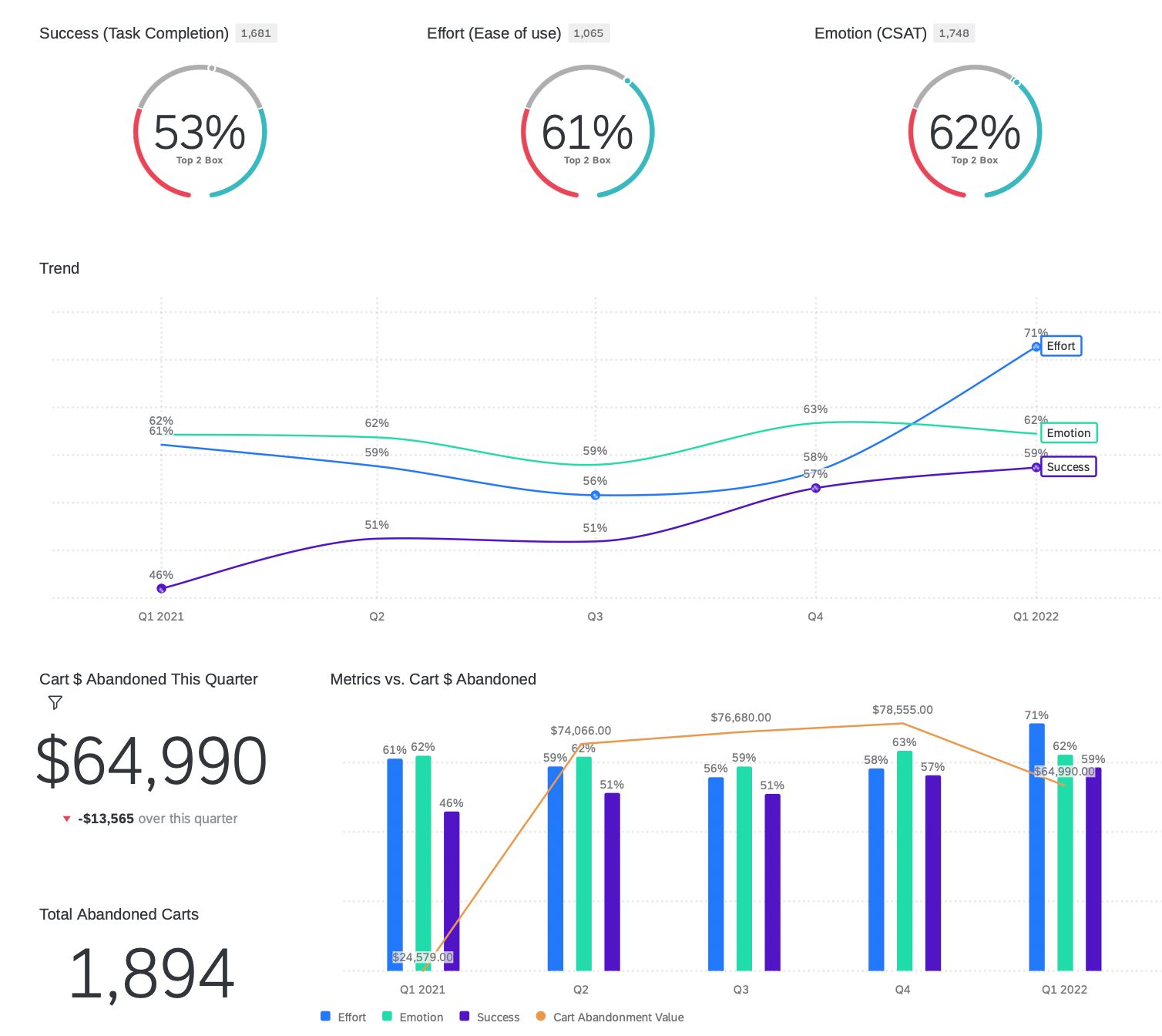
(Image Source: Qualtrics)
Qualtrics is an enterprise-level customer effort score survey software. You can use Qualtrics’ drag-and-drop survey builder to create professional surveys. I used its pre-built templates and question library – quite a decent collection.
You can also use the software’s logic and branching features to make surveys more dynamic and personalized. Qualtrics integrates with many platforms and systems, such as Salesforce, Marketo, Tableau, etc. This gives you the chance to collect and sync feedback from multiple sources and channels.
From designing sophisticated surveys to analyzing data in real time, the tool provides businesses with the means to measure customer effort efficiently.
Pros:
- Highly customizable survey builder with advanced logic
- Multiple question types (including CES) and answer options
- Integrated data analysis and reporting capabilities
- Multilingual support for global customer feedback collection
- Seamless collaboration and sharing options for survey projects
Cons:
- Pricing plan is not transparent
- Steeper learning curve compared to other tools
Pricing:
Starts at $1500/year (custom pricing plans).
5. InMoment – Best for Experience Intelligence

(Image Source: Software Advice)
InMoment is a leading provider of experience intelligence solutions. I find it’s a great tool to understand and improve customer and product experiences.
With its comprehensive suite of tools, InMoment enables you to reimagine your CX approach by combining data technology and human expertise. What sets the tool apart is its ability to actively manage brand reputation in real-time, keeping employees engaged and fulfilled.
Personally, I have found InMoment to be a decent tool for businesses looking to accelerate growth and build deep brand relationships.
Pros:
- Enables the creation of tailored surveys (including CES) to gather specific customer insights
- Utilizes natural language processing for deeper insight
- Real-time insights into customer opinions, enhancing the ability to respond promptly
- Market research capabilities to measure the impact of market trends
- Enables on-the-go customer experience management
Cons:
- Pricing is not transparent
- Sentiment analysis may not be accurate for certain languages or contexts
Pricing:
Custom pricing.
6. QuestionPro – Best for Market Research Insights
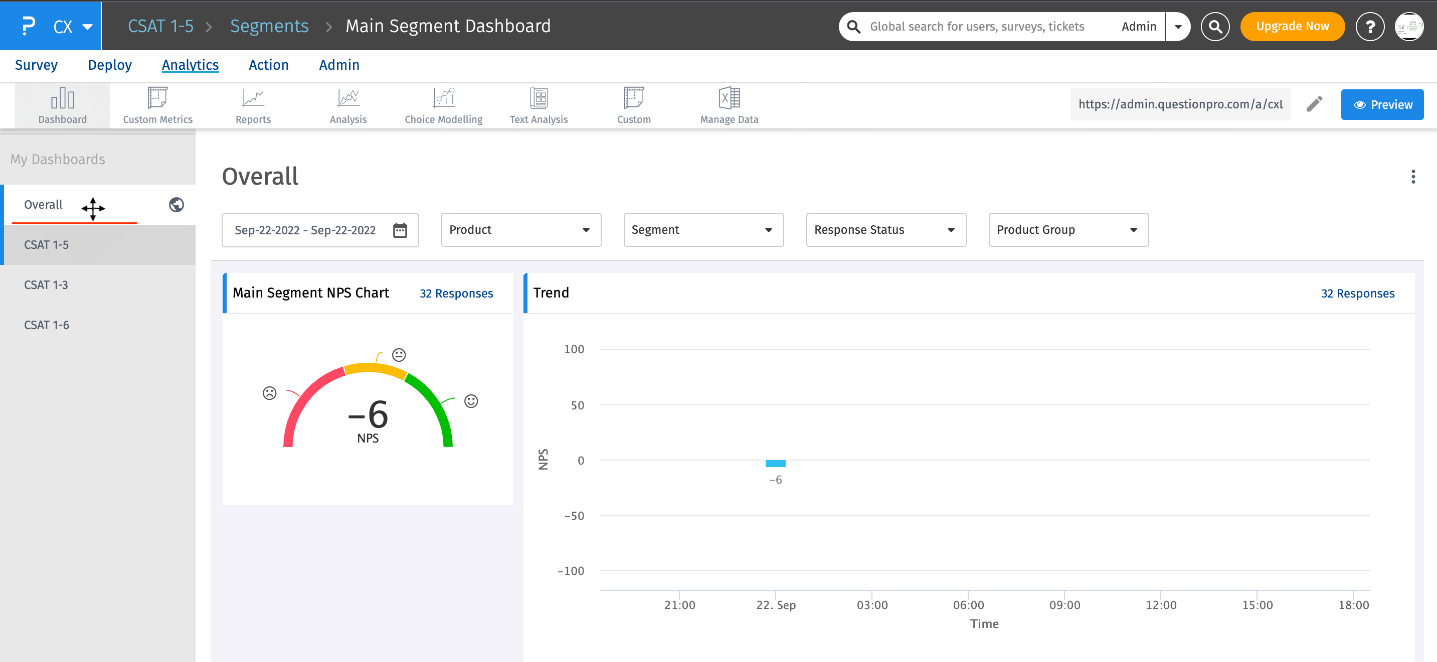
(Image Source: QuestionPro)
QuestionPro is an online survey software that helps you create surveys, polls, quizzes, forms, and more. It enables you to measure and improve your CES, as well as other metrics, such as NPS, CSAT, and VoC.
In my limited time with the tool, I found its ready-made survey templates pretty helpful. You can also create your own from scratch, using a variety of question types, logic, and design options.
QuestionPro is best for market research insights, as it allows you to conduct sophisticated surveys to generate actionable insights. The platform offers advanced features, such as conjoint analysis, maxdiff analysis, trend analysis, etc. – to help you understand customers’ preferences, behavior, and satisfaction.
Pros:
- Transforms CES responses into easy-to-understand graphs and reports
- Exceptional mobile usability, ensuring surveys are accessible on various devices
- Offers a rich library of pre-made survey templates and questions
- Facilitates surveys in multiple languages, catering to a global audience
- Real-time collaboration for team collaboration on survey creation
Cons:
- Users find the interface somewhat outdated and visually unappealing
- A few users have reported occasional delays in customer support responses
Pricing:
A free plan is available for a single user. Paid options start from $99/user/month.
7. SurveySparrow – Best for Omnichannel Experience Management
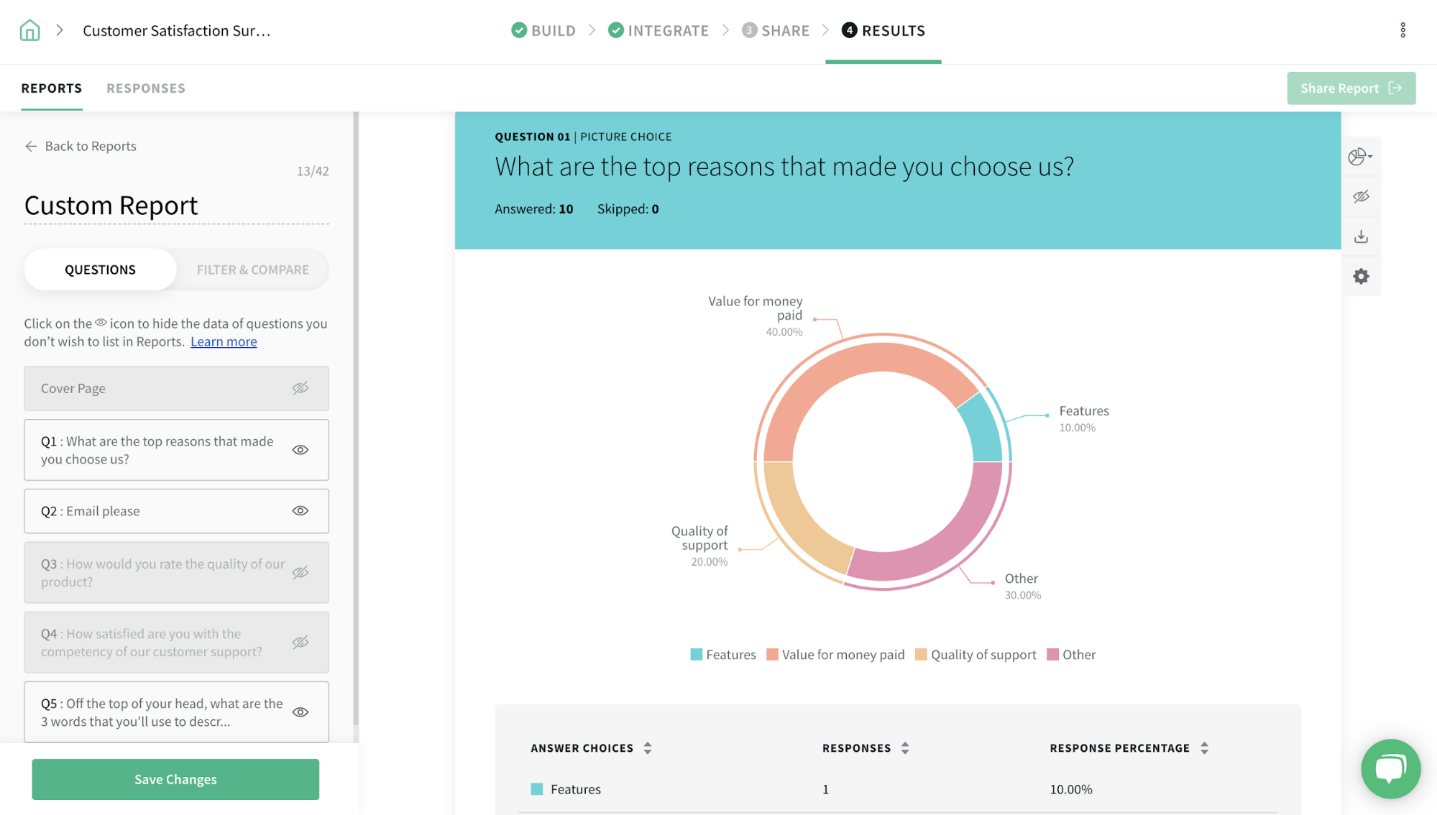
(Image Source: SurveySparrow)
If you’re looking for a customer effort score software that excels in omnichannel experience management, look no further than SurveySparrow. This tool enables businesses to seamlessly collect feedback across multiple channels, providing a holistic view of customer experiences.
The software enabled me to collect and manage feedback from various touchpoints and platforms and deliver personalized experiences to customers. You can also leverage the tool’s advanced features, such as sentiment analysis, recurring surveys, white-labeling, and offline surveys, to enhance your survey capabilities and outcomes.
Pros:
- Ability to create personalized CES surveys with company logos and tailored questions
- Omnichannel survey distribution across web, mobile, email, and more
- AI-powered feedback collection for personalized insights
- Advanced targeting options for reaching specific customer segments
- Provides built-in templates for quick and easy survey creation
Cons:
- Some users experienced difficulties with customizing the layout of survey forms
- Some users reported occasional delays in survey email delivery
Pricing:
Starts at $19/month (custom pricing).
8. Typeform – Best for Interactive & Conversational Surveys
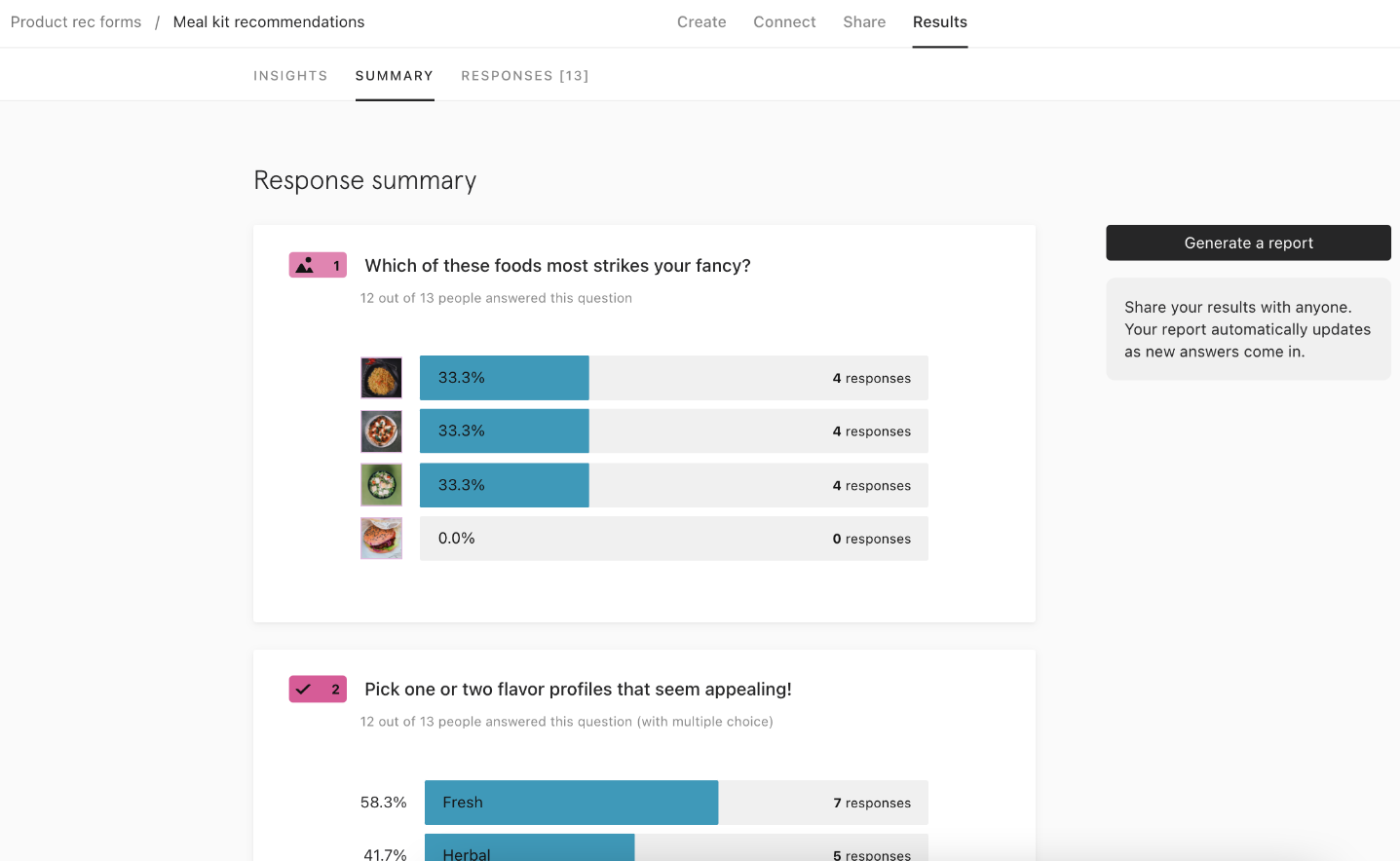
(Image Source: Typeform)
When it comes to capturing customer feedback in an engaging and interactive manner, Typeform stands out as a go-to solution. It provides a visually appealing and conversational survey experience that keeps respondents hooked.
By offering a wide range of question types and customization options, Typeform empowers businesses to create surveys that feel like a natural conversation. It offers various features, such as logic jumps, calculations, file uploads, and video questions, to make your surveys more dynamic and personalized.
Pros:
- Conversational, one-question-at-a-time survey flow
- Wide range of question types (including CES surveys) and customizable templates
- Advanced customization options for enhanced branding
- Real-time data analytics for immediate insights
- Mobile optimization to ensure surveys are responsive on all devices
Cons:
- Conditional logic options can be slightly complex for beginners
- Limited options for scaling surveys to a large audience
Pricing:
Starts at $25/month.
9. Jotform – Best for Creating Online Forms
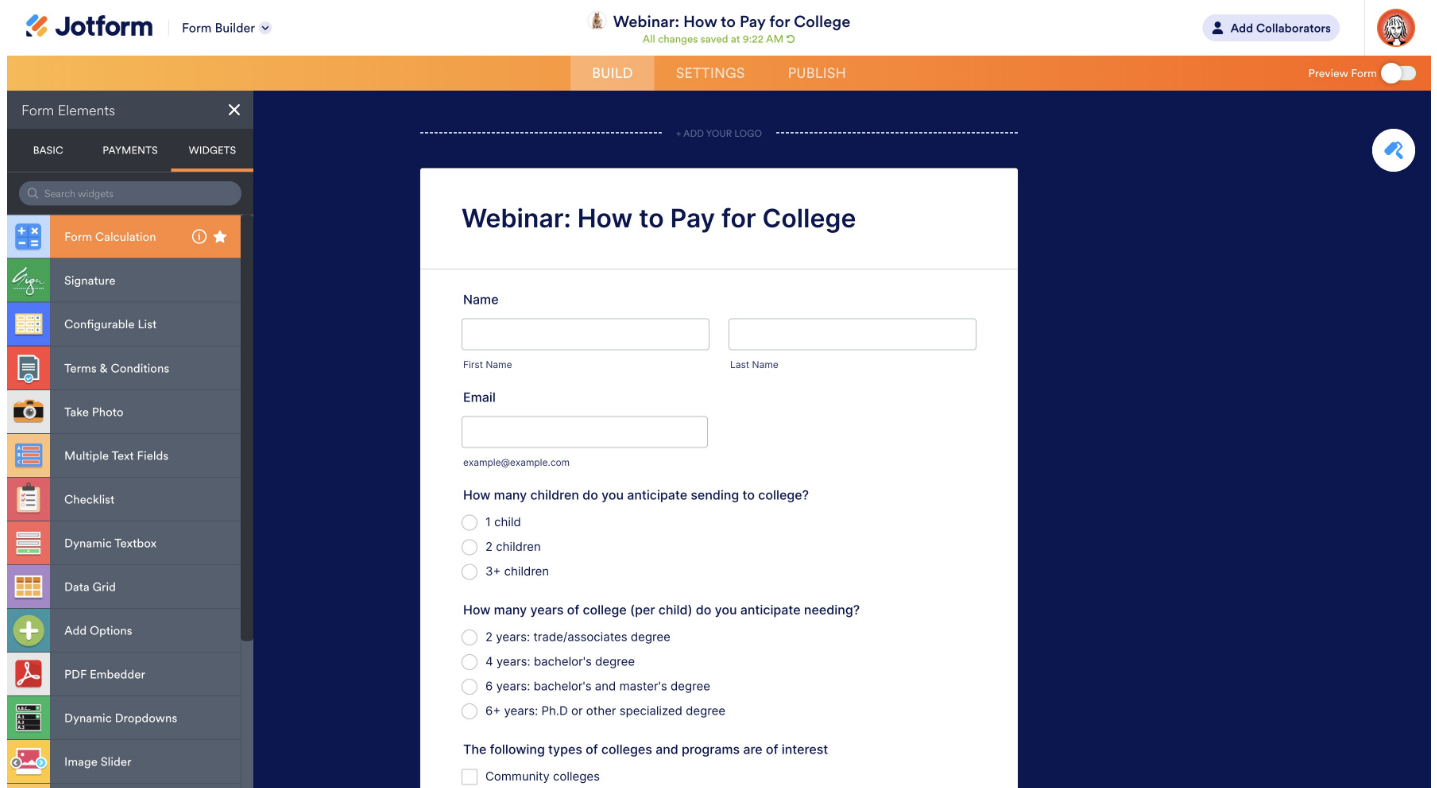
(Image Source: Jotform)
Jotform stands out as an excellent choice for businesses looking to create online forms effortlessly. Though not specifically designed for CES measurement, the software’s simplicity and versatility make it an ideal tool for gathering customer feedback through forms.
Jotform’s platform offers various features, such as conditional logic, calculations, file uploads, and signatures, to make forms more functional and customized. You can also integrate Jotform with various tools, such as Google Drive, Dropbox, PayPal, and Stripe, to connect your data and automate workflows.
In my experience, it’s a decent customer effort score survey software if you are ready to get the paid plans.
Pros:
- Extensive library of pre-built form templates
- Allows personalization of forms to fit brand aesthetics
- Advanced form customization options for branding and design
- Real-time notifications and collaboration features
- Easy data management and analysis through Jotform Insight
Cons:
- Limited functionality for complex forms or surveys compared to other software options
- Some users have reported occasional glitches during form creation or submission
Pricing:
A free plan is available for only 5 forms. Paid options start from $34/month.
What to Look for in CES Software?
The right customer effort score software should do more than collect numbers. It needs to fit the way your team works and make it easy to act on what customers tell you. Here’s what matters most:
- Survey Creation & Customization: You need surveys that feel like your brand and ask the right questions. Look for drag-and-drop builders, logic branching, and templates to make surveys engaging and relevant.
- Multichannel Distribution: Customers interact across web, mobile, email, and more. Your tool should meet them there with flexible, device-agnostic options.
- Analytics & Reporting: Raw scores aren’t enough. You need dashboards, segmentation, and trend analysis to turn data into stories your team can act on. Bonus points for word clouds or sentiment analysis to dig into the “why.”
- AI-Powered Insights: Manual analysis is slow. AI-driven tools can spot patterns, like recurring complaints, without you sifting through responses.
- Integrations: Effort data should flow into your CRM, helpdesk, or analytics platforms (e.g., Salesforce, HubSpot) for seamless action.
- Closing the Loop: High-effort interactions need fast follow-ups to prevent churn. Look for tools that flag issues and trigger workflows.
How to Improve Your Customer Effort Score (Beyond Tools)
Customer effort score software helps you measure friction, but the real gains come from what you do with the insights. Here’s how to reduce effort in ways that actually work:
1. Reduce Channel Friction
If a customer starts on chat but needs phone support, don’t make them repeat their story. Route the context directly to the agent so the handoff is seamless. That’s how a CES survey tool helps you spot where channels break down.
2. Empower Self-Service
An FAQ isn’t enough if it’s buried three clicks deep. Place knowledge base articles right inside your product or app. A CES survey app can flag questions customers try to solve themselves but fail, showing you what content to improve.
3. Speed Up Resolution
When a support ticket sits too long, CES survey software should trigger an alert. For example, if “time to resolution” spikes, managers can step in before the customer leaves frustrated.
4. Meet Customers Where They Are
If 60% of your feedback comes from mobile, your customer effort score platform should deliver mobile-first surveys. Think one-tap responses after a chat session instead of a long email form hours later.
5. Build Trust After Effort Spikes
If a customer gives low CES feedback, set up an automated follow-up within 24 hours. A quick apology and a clear fix turn a bad moment into a recovery. Without closing the loop, you lose both the insight and the customer.
FREE. All Features. FOREVER!
Try our Forever FREE account with all premium features!
Choosing the Right CES Tool for Your Job
Customer Effort Score is a direct signal of loyalty. A low score means customers are working too hard, and that usually ends in churn. The right customer effort score software helps you find those friction points fast and act on them.
ProProfs Survey Maker is a solid choice if you want a CES survey tool that’s simple to set up yet powerful enough to deliver real insights. With ready templates, multichannel options, and reporting features, it makes running CES surveys straightforward without adding extra effort for your team.
Whichever customer effort score platform you choose, test it with a free trial or demo and see how well it fits your workflow. The sooner you reduce customer effort, the sooner you’ll see loyalty, retention, and repeat business rise.
Frequently Asked Questions
What’s the difference between CES and CSAT, and when should I use each?
CES focuses on the ease of a task, such as “How easy was it to resolve your issue?” CSAT looks at overall satisfaction, such as “How satisfied are you with the service?” Use CES survey software to spot friction points, like onboarding or checkout problems. Use CSAT to measure bigger milestones. Pairing both in a customer effort score platform gives you the full picture.
How do I calculate CES from survey responses?
Add up all the ratings and divide by the number of responses. On a 1-7 scale, if the scores are 5, 4, 7, 6, and 4, the total is 26 and the average is 5.2. Track trends over time rather than one-off numbers. Most customer effort score software automates this calculation so you can skip the spreadsheets.
Can CES be used for employee feedback, like internal support?
Yes. Swap “customer” for “employee” and you have a way to measure effort in IT tickets, HR requests, or internal tools. A CES survey app can highlight pain points like login issues or slow approvals. Companies that act on this feedback often see higher productivity and lower turnover.
How does CES tie into reducing churn in SaaS products?
Low effort equals retention. A CES score below 4 often predicts churn rates rising by 20%. Running CES surveys after onboarding, feature launches, or support requests helps you fix issues fast. Pair CES survey data with usage analytics, and you get an early warning system for churn. That’s where a customer effort score platform becomes essential.
FREE. All Features. FOREVER!
Try our Forever FREE account with all premium features!

 We'd love your feedback!
We'd love your feedback!
 Thanks for your feedback!
Thanks for your feedback!



